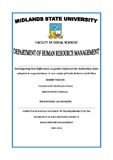Please use this identifier to cite or link to this item:
https://cris.library.msu.ac.zw//handle/11408/2174Full metadata record
| DC Field | Value | Language |
|---|---|---|
| dc.contributor.author | Ndiura, Tinashe Juliet | - |
| dc.date.accessioned | 2017-06-23T08:43:27Z | - |
| dc.date.available | 2017-06-23T08:43:27Z | - |
| dc.date.issued | 2016 | - |
| dc.identifier.uri | http://hdl.handle.net/11408/2174 | - |
| dc.description.abstract | This research explains how gender differences influence the leadership styles adopted at FRGM. The research examined whether men and women really have different leadership behaviours, highlighted the possible factors that may influence their differences in leadership behaviours such as biological differences, structural differences and also looked at the role society and culture play in shaping the leadership behaviour of male and female leaders, looked at other factors apart from gender difference that can influence leadership styles as well as assessing how different leadership styles affect employee’s motivation. The Interplanetary theory of gender differences by Kimmel (2004) theoretically guided the research. A qualitative research approach was used and the research instruments used included questionnaires, interviews and the Likert scale. The research also made use of exploratory research design. Judgemental non-random sampling was used and a sample size of 35 people drawn from both male and female managerial and non-managerial employees at FRGM. Thematic analysis was adopted as the method of data analysis for the study. The findings revealed leadership styles are not gender determined but rather, male and female leadership behaviour is contigent on situational factors. Other factors such as level of experience, national culture and the characteristics of subordinates play a vital role in influencing the way male and female leaders lead. It was also revealed that even though males and females differ biologically and the way they are socialised differs, there are little or no differences in the way they lead as the situation one will be facing is the decisive factor. Even though some respondents highlighted that leadership styles adopted by their managers motivate them to perform better, it was revealed that it rather takes a lot to motivate an employee hence other factors such as rewards, sense of job security were also found to be essential for employee motivation. The characteristics of a good leader in a mining set up were also identified. Conclusions made were that women in the mining sector continue to be underrepresented in positions of power and female leadership still faces stereotypical views. Recommendations forwarded by the researcher include having a workplace culture that is inclusive and embraces gender diversity and putting in place awareness programmes such as workshops so as to sensitize employees at FRGM about male and female leadership. | en_US |
| dc.language.iso | en | en_US |
| dc.publisher | Midlands State University | en_US |
| dc.subject | Gender | en_US |
| dc.subject | Leadership | en_US |
| dc.title | Investigating how differences in gender influence the leadership styles adopted in organisations: a case study of Freda Rebecca Gold Mine | en_US |
| item.grantfulltext | open | - |
| item.fulltext | With Fulltext | - |
| item.languageiso639-1 | en | - |
| Appears in Collections: | Bsc Human Resource Management Honours Degree | |
Files in This Item:
| File | Description | Size | Format | |
|---|---|---|---|---|
| Final Dissertation_.pdf | Full Text | 1.7 MB | Adobe PDF |  View/Open |
Page view(s)
238
checked on Nov 23, 2025
Download(s)
168
checked on Nov 23, 2025
Google ScholarTM
Check
Items in MSUIR are protected by copyright, with all rights reserved, unless otherwise indicated.



